
Return to Gazetteer of Lower Palaeolithic sites on Thanet
Display Contents
Gazetteer Link -
Thanet handaxes -
a closer look
Thanet Reach Westwood
Asda Westwood
St. Mildred's Bay
Artefact scales in centimetre divisions
A map of the handaxe find-spots covered in the text below
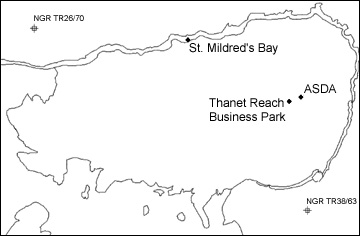
Where two handaxe images are shown they are of both sides of the same object.

Thanet Reach today
This site has proved incredibly
important for Thanet’s early Prehistory,
producing rare evidence of both Palaeolithic
and Mesolithic activity (see the Mesolithic gallery).
This area of Broadstairs has also provided three of Thanet’s handaxes, all within 500m of each other.
This area of Broadstairs has also provided three of Thanet’s handaxes, all within 500m of each other.
Thanet Reach
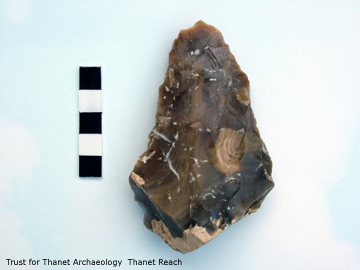
The pointed handaxe
shown above and below is the only Lower Palaeolithic flint from Thanet
that has certainly been discovered virtually in its original ancient
soil deposit. The only other exception may be the Stone House handaxe.
All the rest have been found redeposited
in contexts which formed much later than those into which the tools
would have originally been discarded.
The sharp-eyed driver of a mechanical
digger spotted this handaxe while
excavating foundation trenches through clay deposits several metres
thick
This tool has been perfectly preserved
and is as fresh as the day it was discarded. It could date from
approximately 200,000-500,000 BC plus. The tool is of a type called ‘Acheulian’, named after St. Acheul
in France
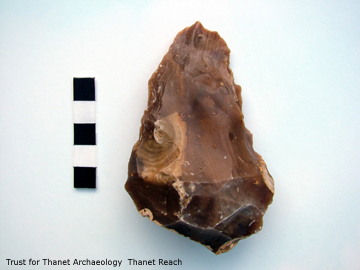
Most of the Palaeolithic
flint tool classifications have elegant-sounding French names because
it was in France
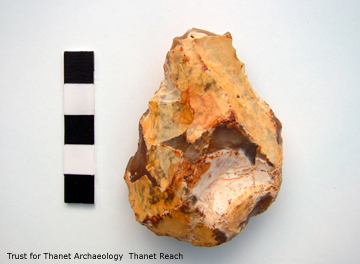
The slightly odd-looking tool pictured
above and below is possibly a small Pointed handaxe.
It was recovered from a spoil-heap at Thanet Reach Business Park
The varying colours
on the surface of the tool tell an interesting story. The yellow-patinated surfaces represent the original flaked
facets of the tool. They sit alongside relatively recently flaked areas
that show as the fresh, un-patinated black
or brown natural colour of the flint.
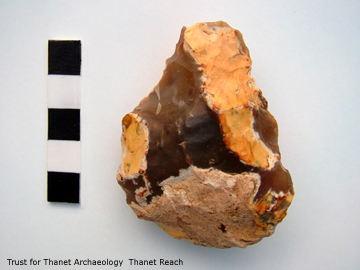
It appears that this Palaeolithic tool was re-discovered by the later
Prehistoric inhabitants of this site and reworked by them to bring the
tool back into use. This happened hundreds of thousands of years after
the original maker had finished with it.
Handaxes
can show a general decrease in size over time, but the period known as
the Hoxnian interglacial (see below) was a
time that
saw some very small handaxe-like tools
produced. One cannot be certain that our tool was produced during this
time however and so we should broadly date it from approximately
200,000-420,000 BC for now.
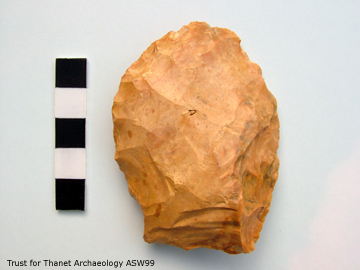
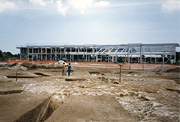
The Asda Superstore Westwood under excavation and construction
An Early Medieval Post-Mill base is in the foreground
This tool pictured above and below is a
variant of the Acheulian type of handaxe known as a 'Twisted Ovate'. It is so
named because the working edge is not straight but twists in an
'S'-shape
around the circumference of the tool. It is the only recorded example
of this type from Thanet.
Its beautiful golden colour is actually a chemical discolouring (patinating)
of the original black colour of the flint,
caused by the ground in which it was first buried. This process of patination has taken place over many thousands
of years.
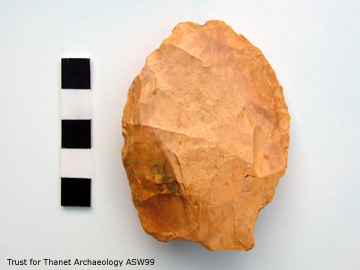
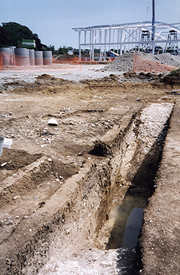
The area of the flint 'floor' at Asda Superstore, Westwood
It sits atop a very large, in-filled pit (perhaps the entrance to a flint mine?)
The axe is not of classical form, having
a slightly flatter base which is perhaps more typical of the later
Middle Palaeolithic ‘Mousterian’ handaxes
produced by the Neanderthals. Those tools do not have twisted edges
however.
This axe was found in 1999 in
excavations at the site of the Asda
Superstore in Broadstairs. It came from a
Later Prehistoric ‘floor’ made of flints which were laid several
hundred-thousand years after the axe was first made.
It must have been rediscovered by the
later inhabitants of what had by then become the Isle of Thanet and perhaps deemed particularly suitable
for use
in their floor, on account of its flat surfaces.
They would certainly have recognised it as a tool and perhaps had kept it
for a time as a curio. Whether they had found it
close to their settlement or collected it from further away is
impossible to say, unfortunately.
All handaxes
are difficult to date precisely, once they have been removed from the
original context of their disposal. However this type most commonly
occurs in the Hoxnian interglacial period,
possibly around 360,000-420,000 BC.
St. Mildred's Bay, Westgate
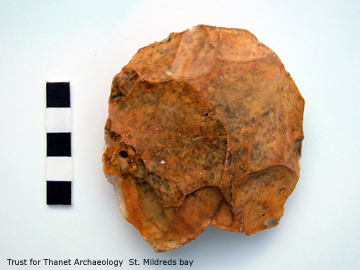
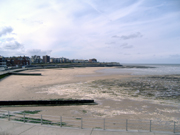
St. Mildred's Bay, Westgate
The Ovate Acheulian
handaxe shown above and below was
found on the beach at St. Mildred’s Bay, Westgate in the late 1990’s.
Its colourful patina is common to flints
recovered from river deposits and may suggest that this example could
have been preserved in an ancient river bed before coastal erosion
brought it to the find spot.
Evidence for later settlement in this
area in the Neolithic, Bronze Age, Iron Age, Roman and Saxon periods
has been
recovered from the shifting sands and it is possible that the handaxe could have been brought here during one
of these later periods, perhaps being picked up as a curio.
In this scenario a possible origin for
the tool might be further up the coast at Bishopstone
Glen, which is known in modern times as a place where handaxes can erode out of the cliffs.
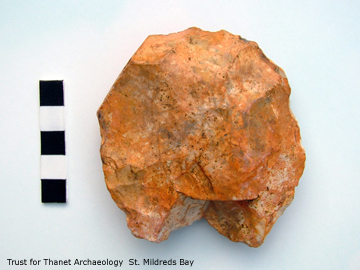
However, natural flints of identical patination can be found throughout St. Mildred’s
Bay and this suggests that both they and this handaxe
originate from an ancient Thanet stream
which once flowed through this area of Westgate. Its remains can still
occasionally be seen on the beach.
Again, this handaxe
cannot be firmly dated, but would broadly date from approximately
200,000-500,000 BC plus.
Thanks go to Webmeister Ges Moody for the map.
Version 1 - Posted 30.03.05
Version 2 - Posted 10.04.06
Version 3 - Posted 14.05.06
Version 4 - Posted 25.07.06
Version 5 - Posted 21.10.06
Version 6 - Posted 16.12.06
All
content © Trust for Thanet Archaeology